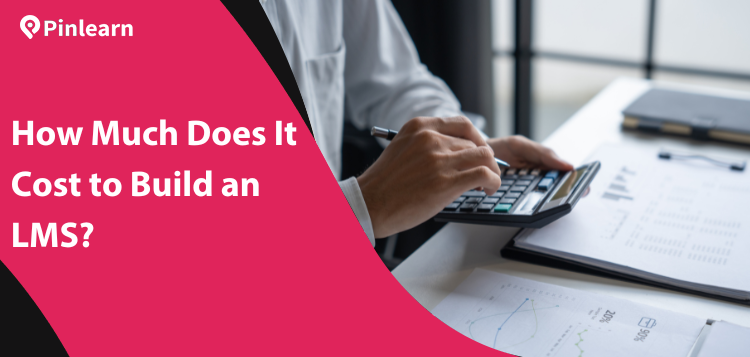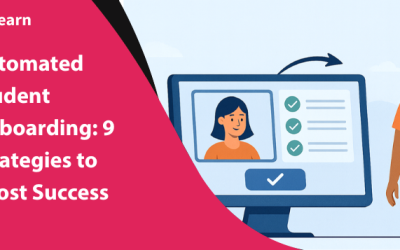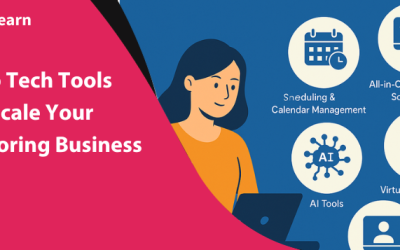How Much Does it Cost to Build an LMS?
Building your own LMS? The process of developing an LMS involves multiple phases and careful consideration of several factors. From a well-tuned development approach to skilled expertise, the final result is a seamless amalgamation of the right choices.
And of course, cost is a detrimental factor that moulds these choices. So, how much does it cost to build an LMS? In this blog, we break down the LMS development cost based on all the known factors, so make better-informed choices.
Let’s get into this deep dive!
What are the Factors Affecting LMS Development Cost?
Before we move on to the detailed cost analysis of LMS, consider the key factors influencing the overall cost. Here we briefly explain each in detail.
Factor # 1: LMS Functionality
The feature set of your LMS is one of the essential factors affecting the overall cost. The more complex the features, the higher the cost. For instance, a basic LMS with simple course creation and management, quizzes, and assessment tools costs less. However, an advanced LMS with an advanced dashboard and analytics, AI features, gamification, and personalisation incurs a higher cost.
Factor # 2: Third-party Integration
While the level of customisation & third-party integrations depends on business goals and learning objectives, it is a price-impacting factor. Does your LMS have branding or customisation requirements? Or does your business need SSO, HRIS, or third-party APIs? Custom LMSs are significantly more costly than off-the-shelf products.
Factor # 3: UI/UX Design
A user-friendly UI/UX design smoothens the learning curve and attracts learners. But usability testing might add to the costs further. However, it’s cost-effective in the long run!
Factor # 4: User Base and Scalability Requirements
Accommodating thousands of users’ requires performance optimization and efficiency. And a scalable infrastructure further increases the overall development cost.
Factor # 4: Team Composition & Developer Rate
A complex team with more members is difficult to manage and increases your development cost. Increased salaries, reskilling and coordination contribute to the overall cost. Moreover, the location of your development team matters. Often, on-shore development costs more than off-shore development. On the upside, hiring developers outside your country offers access to a talented and diverse pool of expertise.
Factor # 5: Tech Stack Selection
Programming languages, frameworks, tools & technologies also influence your LMS project’s budget. Modern and cutting-edge technology improves efficiency but demands skilled developers.
Additionally, factors like maintenance and support costs, training, localization, and licensing fees stretch LMS cost estimates.
How Much Does it Cost to Build an LMS?
The overall cost to build an LMS ranges from $25,000 to over $200,000, depending on whether you’re building a basic LMS or a customized one. Let’s break down the cost based on each of the above factors.
LMS Cost Breakdown Based on Feature Complexity
Here’s a quick table on cost for developing different LMS features:
| Features | Development Cost ($30 per hour) | Development Time |
| User Registration, Management & Roles | $6000- $7200 | 5 – 6 weeks |
| Course Creation & Management | $3600 – $4800 | 3 – 4 weeks |
| Assessments/ Quizzes | $2400 | 2 weeks |
| Payment Gateway Integration | $2400 | 2 weeks |
| Progress Tracking | $2400 – $3600 | 2 – 3 weeks |
| Certificate Generation | $2400 – $3600 | 2 – 3 weeks |
| Analytics & Reporting | $7200 – $9600 | 6 – 8 weeks |
| Security & Compliance | $3600 – $4800 | 3 – 4 weeks |
| Total Development Costs | $30,000 – $ 38,400 | 6 – 8 months |
Here’s a brief description of each of the features:
1. User Registration & Management
Admins should be able to create and manage user profiles, assign roles and permissions, and handle student enrollments. For example, instructors should be able to manage and edit courses, while students should be restricted to course access.
Cost: $8000- $9600
Development Time: 5 – 6 weeks
2. Course Creation & Management
Your course content is never static; it evolves with product and market shifts or changes in legal regulations. Course management allows admins to update content, restructure, or even create new content modules (course authoring).
Cost: $4800 – $6400
Development Time: 3 – 4 weeks
3. Assessments/Quiz
Monitor learners’ progress with assessments, quizzes, interactive video assignments, surveys, etc. The results point out learners’ strengths and possible areas for improvement.
Cost: $3200
Development Time: 2 weeks
4. Payment Gateway Integration
If you sell courses on LMS, connecting with a reliable payment gateway is crucial. Stripe and PayPal are two popular payment gateways that enable payments through cards, wallets, and local payment methods.
Cost: $3200
Development Time: 2 weeks
5. Progress Tracking
Include progress bars, dashboards, and completion certificates for progress tracking in your LMS. Beyond learners’ progress, these features incentivize learning, boost engagement and motivate learners.
Cost: $3000 – $6000
Development Time: 2 – 3 weeks
6. Gamification
Gamified elements like points, badges, leaderboards, and social learning make learning more fun and interactive. Further, this enhances retention, engagement and learning less of a chore.
Cost: $4500 – $7000
Development Time: 4 – 6 weeks
7. Certificate Generation
Certificates at the end of each module or entire course provide a sense of achievement. Ensure LMS can store certificates and allow admins and learners to download them on course completion.
Cost: $2500 – $4000
Development Time: 2 – 3 weeks
8. Analytics & Reporting
LMS analytics tracks, collects, and analyzes learners’ progress and platform performance. User engagement, learner satisfaction, test scores, and course progress are top LMS metrics. With these metrics, admins and instructors can optimize the content and teaching methodologies.
Cost: $9600 – $12,800
Development Time: 6 – 8 weeks
9. Security & Compliance
Unauthorized access to course content exposes your confidential data. Level up LMS security with advanced authentication, SSO, complex passwords, data backups and audit logs.
Cost: $4500 – $6000
Development Time: 3-4 weeks
Cost Breakdown Based on Feature Complexity:
| LMS Complexity | Features | Development Cost |
| Basic LMS | Course creation & management, user registration, progress tracking, payment & basic reporting, progress tracking | $15,000 – $35,000 |
| Mid-Level LMS | Mobile responsiveness, live lessons, some integrations & better design | $40,000- $70,000 |
| Full-feature LMS with customization | Gamification, AI, custom dashboard, quiz, certification, localization, personalized learning paths | $80.000 -$200,000 |
Cost Estimate Based on Type of Solution
A comprehensive view of the LMS solutions available helps to decide the right option for your business. Let’s look into the different types of LMS solutions for your organization!
Ready-made LMS
Looking for a quick deployment & proven industry solution? Ready-made LMS solutions like Pinlearn are great, pre-loaded with core features and functionalities. From powerful course management, analytics and reporting, you can focus on teaching and learning. This minimizes the development cycle where customization and core-feature development happen simultaneously!
⚡ Our MVP helps you launch a robust LMS within weeks with the core features (starts at $699). Need a tailor-made, customized learning solution fine-tuned to your unique business needs? We excel in custom LMS development as well. Build a powerful LMS with comprehensive learning paths & an unparalleled user experience! Reach out to our team on Whatsapp to get your personalized quote!
Key Features:
- Quick deployment in weeks
- Cost-effective
- Highly customizable
- Shorter development cycle
- One-time cost/subscription fees without hidden costs
- Self-hosted & open-source code access
- Timely support & updates
Custom LMS
If you have specific business needs or specifications, a custom learning management system is an ideal solution. However, building from scratch requires careful planning, implementation, and infrastructure setup. Custom LMS development cost demands a higher budget, extra effort, and a dedicated team to align development to workflows.
Key Features:
- Tailored to business-specific workflows & user experiences
- Personalization
- Scalability & Integration
- Full control & ownership
Cloud-based or Saas LMS
A Saas LMS can be accessed by learners 24/7 from anywhere, provides flexibility and is compatible with any user device. The learning program is cloud-hosted on a central server and not tied to any specific computer or hard drive.
Key Features:
- Scalability
- Cloud security
- Security & data privacy
- Quick Implementation
- No hardware maintenance required
- Actionable analytics & insights
Examples: TalentLMS, Docebo, Absorb LMS
Open-source LMS
Open-source LMSs are widely popular, and the source code is available for free public access. Businesses and organizations typically modify the source code to adapt to their learning environment. These solutions are cost-effective and highly customizable.
Key Features:
- No licensing fees
- Customization & plug-ins
- Community support
- Integration capabilities
- Collaboration
- Reporting & analytics
Examples: Moodle, Open edX, Canvas
Here’s a cost comparison based of different LMS types:
| LMS Types | Development Cost |
| Ready-made LMS | Starting from $699 (Pinlearn) |
| Custom LMS | $30,000 – $40,000 |
| Saas-based LMS | $50,000 – $200,000 |
| Open-source LMS | $30,000 – $80,000 |
Cost Breakdown Based on Development Process
Here’s how the LMS cost unfolds through different development phases:
| Development Phases | Development Cost |
| Research & Planning | $2,000 – $4,000 |
| UI/UX Design | $10,000 – $20,000 |
| Core Functionality | $20,000 – $35,000 |
| Customization | $10,000- $100,000 |
| Integrations | $20,000 – $40,000 |
| Training Costs | $2,000 – $6,000 |
| Marketing Costs | $5,000 – $7,000 |
| Maintenance Costs | $5,000 – $7,500 |
| Licensing Costs | $2,000 – $10,000 |
Ongoing Development Costs
While development is a crucial phase for an LMS project, the cost estimation goes beyond that. Even after the initial product launch, there’s an ongoing cost from maintenance, technical support, updates & feature enhancements, etc.
-
Maintenance & Support Costs
Regular patches, bug fixes & technical support keep your LMS up-to-date and reduce the risk of vulnerabilities. Typically, it is 10% – 20% of the learning management system development cost. Feature & design upgrades are also part of the maintenance cost and ensure a seamless platform experience.
Cost: $2,500 -$5,000 per month
-
Hosting & Server Costs
Self-hosted LMS requires separate cloud hosting costs, while for Saas LMS, it is covered in basic hosting. AWS, Digital Ocean, and Azure are popular hosting servers.
Cost: $100 – $1500 per month
-
Licensing & Third-Party Tools
The licensing costs for LMS vary depending on the type of LMS solution you choose. While open-source LMSs are often free to use, there’s an investment in terms of setup, maintenance, and programming. For SaaS LMS, there’s a monthly or annual subscription fee for platform access. Alternatively, ready-made scripts incur a one-time cost with no hidden expenses.
Video streaming, payment integrations, email marketing and analytics are common third-party integrations.
Cost: $50 -$500 per month
Furthermore, there are some obvious non-monetary costs like the time needed for customization, effort for data migration, and onboarding efforts.
How to Reduce LMS Development Cost?
Below are the different ways to cut down your LMS development cost:
-
Focus on Essential Features First
Build an MVP prioritizing the core features like user registration, course management, progress tracking, etc. This saves cost and also helps you build the right product that resonates with learners.
-
Outsource Development Off-Shore
Outsourcing development to talented and quality offshore teams cuts down the overall cost by 50% -60%. Typically, the labour cost is lower in Eastern Europe, Asia and Latin America.
-
Choose Agile Approach
Embrace modern and agile approaches like Scrum to save your time and budget. They offer efficiency, speed, and iterative development, streamlining development.
-
Use Pre-Built LMS Scripts
Pre-built LMS scripts cover the essential features & functionalities with proven industry expertise. This shortens development cycles, reduces cost and assures market success.
-
Reuse Components
Wherever possible, include open-source plugins, pre-built UI kits, and similar modules to speed up and reduce cost.
Wrapping Up
Now, you have the cost estimate for building a robust LMS for your organization or business. Whether you’re looking for a basic or custom LMS tailored to your business, Pinlearn is a trusted partner for building an innovative LMS solution.
With proven experience in the edtech industry, we specialize in building customized learning solutions that offer course creation & management, analytics, progress tracking and engagement features.
Empower your entrepreneurial journey in the edtech industry with Pinlearn today!
FAQ-Related to How Much Does it Cost to Build an LMS
1. How much does it cost to build an LMS?
The overall development cost ranges from $40,000 to over $200,000, depending on whether you’re developing a basic LMS or a full-fledged customised one. Feature complexity, tech stack, hourly developer rate, and integration also influence LMS cost.
2. Can you build your own LMS?
Yes, you can build your own LMS based on organizational and business needs. Building a custom LMS is best for customized workflows, unique branding, full control, and a scalable business model. However, choose the development solution based on immediate goals, scalability, timeline, and budget.
3. How much time does it take to build an LMS?
Building an LMS requires a few months or a year, depending on feature complexity, customization, integration, development approach, and scalability needs.
4. What are the steps to develop an LMS?
The following are the key steps to develop an LMS:
- Research Idea & target Audience
- Market research
- Validate your business idea
- Design UI/UX for LMS
- Determine core & advanced features
- Choose the right development approach
- Launch and maintenance of LMS





